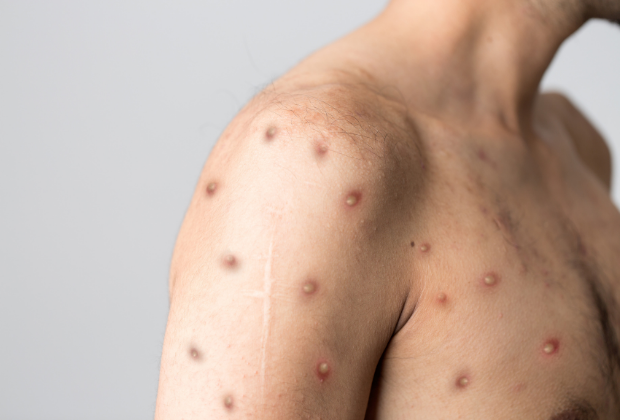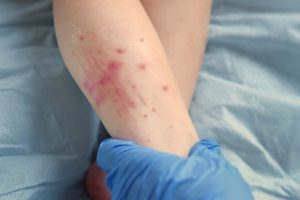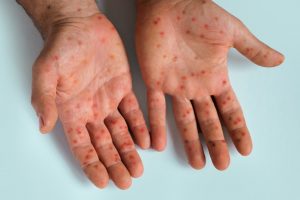1. What is monkeypox?
Monkeypox is caused by infection with monkeypox virus, a member of the genus Orthopoxvirus in the family Poxviridae. There are currently more than 80 poxviruses known to science and these poxviruses have been isolated from different species of birds, insects, reptiles, marsupials and mammals. Poxviruses that may cause human disease include the smallpox (or variola) virus and molluscum contagiosum virus. The former was eradicated by 1980 by mass-vaccination programs. In addition human disease can be caused by infection with monkeypox, orf, cowpox and Tanapoxviruses. These viruses are harbored by different animal species and may spillover to the human population (i.e. they are zoonotic viruses) when there is sufficient exposure. These viruses are not highly transmissible from person-to-person.
2. Where does monkeypox occur?
Monkeypox was first discovered in 1958 in Denmark when two outbreaks of a pox-like disease occurred in colonies of monkeys kept for research, hence the name ‘monkeypox.’ The first human case of monkeypox was recorded in 1970 in the Democratic Republic of Congo. Monkeypox is endemic (or naturally occurring) in countries from central and western Africa. This distribution of monkeypox virus is attributed to the fact that it is naturally harboured by animals that are found in this part of Africa. It is believed that rodents, most likely certain species of squirrels found in the deep forested areas of the endemic countries, may be the natural host of the virus. Monkeypox infections in humans are noted in the endemic countries albeit at a relatively low level. An increase of human monkeypox have been noted in recent years from Nigeria but also other locations in the Region. Human cases of monkeypox have been reported outside of the endemic countries in the US in 2003 in an outbreak related to the exotic pet trade. In addition, cases of monkeypox have been reported in Israel, Singapore and the United Kingdom. On 13th May 2022, World Health Organization (WHO) was notified of two laboratory confirmed cases and one probable case of monkeypox, from the same household, in the United Kingdom. Since the disease has been detected in a number of European countries, the USA and Australia. Updates on the development of this outbreak is available from the NICD website.
3. How is monkeypox virus transmitted?
Monkeypox virus can be transmitted to a person upon contact with the virus from an animal, human, or materials contaminated with the virus. Entry of the virus is through broken skin, respiratory tract, or the mucous membranes (eyes, nose, or mouth). In endemic countries, the monkeypox virus may be spread from handling infected bush meat, an animal bite or scratch, body fluids and contaminated objects. In Africa, monkeypox infection has been found in many animal species: rope squirrels, tree squirrels,Gambian rats, striped mice, dormice and primates. Certain species of rodents are suspected of being the main disease carrier (reservoir host) of monkeypox, although this has not been proven yet. In non-endemic countries persons are most likely to be exposed to monkeypox through contact with an individual that is already sick with monkeypox. Cases of monkeypox spreading through animals, outside of the endemic areas, are very rare, but may involve the exotic pet trade or potential through contact with infected animal-derived materials such as skins and leather. Person-to-person transmission involves close contact with an infected person or materials that have been contaminated by an infected person.
4. What are the signs and symptoms of monkeypox?
The incubation period (time from infection to symptoms) for monkeypox is on average 7−14 days but can range from 5−21 days. Initial symptoms include fever, headache, muscle aches, backache, chills and exhaustion. Within 1-3 days of onset of disease, blister-like lesions (very much the same as chickenpox) will develop on the face, the extremities including soles of the feet and palms of the hands. The lesions may however occur on other parts of the body. The number of lesions will vary and not all lesions will be at the same stage of development. The lesions progresses through several stages before scabbing over and resolving. Most human cases resolve within 2-3 weeks of onset without side-effects. The case fatality rate in more recent outbreaks have been on average 1%.
5. When is a monkeypox infected person no longer contagious?
An infected person is contagious from the onset of the rash/lesions through the scab stage. Once all scabs have fallen off, a person is no longer contagious.
6. How is monkeypox diagnosed?
Monkeypox is diagnosed by a healthcare worker in consideration of the clinical presentation of the patient. The rash would be the most telling sign. However, the healthcare worker will consider possible exposures for the case with the consideration that the likelihood of contracting monkeypox is very low. Many other diseases, such as chickenpox, may cause similar rashes and are more common. Samples can be tested at the National Institute for Communicable Diseases to confirm a diagnosis of monkeypox. For more information on laboratory testing of monkeypox, refer to the NICD website.
7. How is monkeypox treated?
Treatment is supportive, as with most viral infections. Most human cases of monkeypox virus infection do not require any specific treatment and the disease resolves on its own. There are anti-viral drug that a clinician may consider to use for treatment of more severe cases of monkeypox on a case-by-case basis.
8. How can monkeypox be prevented?
In non-endemic countries persons are most likely to be exposed to monkeypox through contact with an individual that is already sick with monkeypox. The spread of monkeypox can then be interrupted by contact tracing for diagnosed persons and isolating any persons that develop the disease. Residual immunity from smallpox vaccination in the population aged 40 and above may also contribute to preventing cases or lead to more mild infections. There is about 85 % protection offered by the smallpox vaccine (which was used to eradicate the human pox virus disease known as smallpox) and monkeypox.
9. What is the risk of contracting monkeypox in South Africa?
The implications for South Africa are that the risk of importation of monkeypox is a reality as lessons learnt from COVID-19 have illustrated that outbreaks in another part of the world can fast become a global concern. The WHO have not recommended any travel restrictions and are working with the affected countries to limit transmission and determine sources of exposure. For anybody entering South Africa, any illness during travel or upon return from an endemic area should be reported to a healthcare professional, including information about all recent travel, immunization history and contact with any known cases. Residents and travellers to endemic countries should avoid contact with sick animals that could harbour monkeypox virus such as rodents, marsupials, primates and should refrain from eating or handling wild game. A good history is important to rule out any other differential diagnoses, including malaria. Residents and travellers to countries affected in the current outbreak, should report any illness to a healthcare professional, including information about all recent travel and attendance of mass gathering events, festivals and parties, and contact with any known cases. The importance of hand hygiene by using soap and water or alcohol-based sanitizer should be emphasized.
10. Where can I find more information?
For healthcare workers: (for medical/clinical and laboratory related queries ONLY): +27 82 883 9920
Other: Guidelines and other useful resources are available on the NICD website: www.nicd.ac.za/monkeypox
Centers for Disease Control and Prevention, Atlanta, United States of America. https://www.cdc.gov/poxvirus/monkeypox/index.html
World Health Organization. http://www.who.int/mediacentre/factsheets/fs161/en/





